|
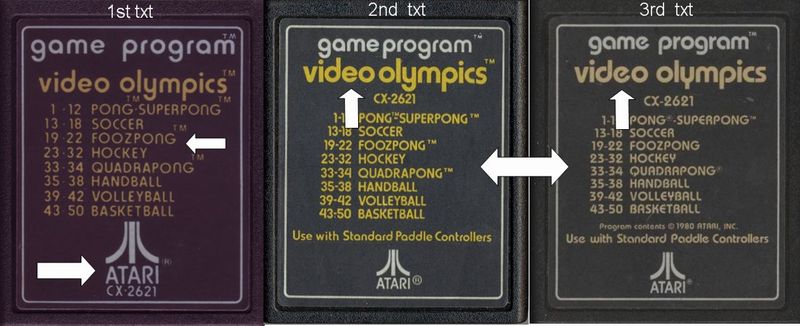
We start with the three text versions. In the photo above, the cartridge on the left is the original release. If for
some reason your end label has fallen off, there are 2 things to look for to know if it's an original, 1st text, gate-fold
game. The letters are larger listing the game options, which you can compare to the other two carts. The easy way is to see
the very large Atari logo at the bottom of the label with the part number printed below it. With the 2nd text version, middle
of the photo, you see that the game options print has gotten smaller. If you look at the arrow pointing up at the word "video",
it points at the "e". The "e" is straight in the 2nd text version. The 3rd text version has the same size game options, but
the arrow now points to an "e" that is slanted. This also goes for the word "game" at the top. All cartridges have the "game"
program written, so that is where you would look for 2nd or 3rd text versions.
The photo below shows the end labels of the same three cartridges from above. The one on the left is the 1st text version.
Notice the number 21 before the game. All the original gate-fold games had numbers before their names. The 2nd text version
again shows the straight "e" and the 3rd text shows the slanted "e".

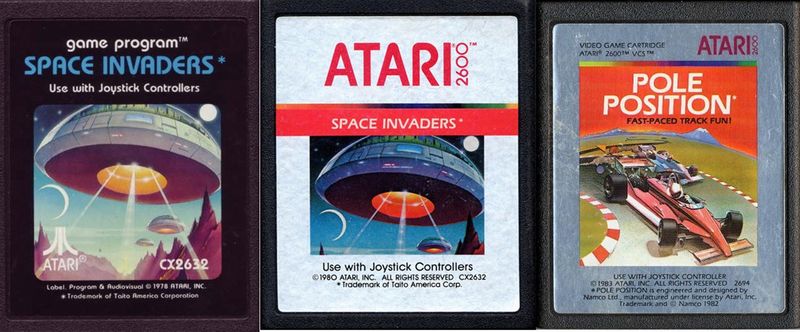
The next photos we'll begin the picture labels. The first one on the left, known as PicBl is your normal black label
with a picture. You will find this on many games, especially those released before 1982 or so. The middle picture was the
next step. Get rid of the black and go to a silver label. This is known as PicSil1. The first silver version has a smaller
picture with the Atari 2600 at the top in the middle. The cartridge on the right is known as PicSil2, the second silver version.
The picture has gotten larger and the Atari 2600 is smaller and moved to the upper right corner.
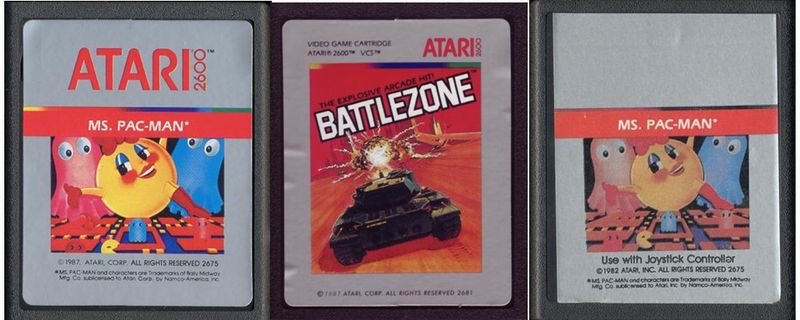
Above we see the Atari grey labels. They are the exact version of the silver variations but have a dull grey color. The
one on the left featuring Ms. Pac-Man is categorized as PicGr1 meaning grey 1. It has the small photo with the large Atari
logo centered above it. The one in the middle, Battlezone, is PicGr2 being the grey 2 version. It has the larger photo
with the small Atari logo moved to the upper right. On the right we see something strange. This Ms. Pac-Man but does not have
an Atari logo. I have scans for 2 variations of this type of label. I don't know where it's from, or that it's possibly a
pirate. I'm showing it here for info purposes and maybe a reputable collector can confirm this is legitimate. I called this
PicGr0 meaning grey 0 because it has nothing. Though I have this in the variation listing, I'm hesitant on calling it real.
If you look at the label, it's longer than the indentation and is square whereas normal Atari labels have rounded corners.
In most cases, cartridges that have the 1st grey also have a 1st silver version. Those that have the 2nd grey usually
have the 2nd silver version.
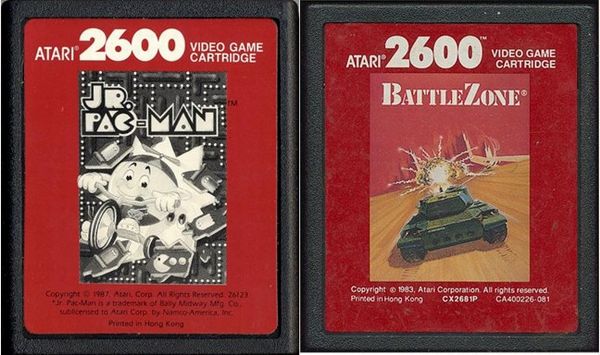
Above are the two red label versions. The only difference between the two is that Picred1, the 1st one Jr. Pac-Man, has
a black and white photo. Picred2, the 2nd red one, Battlezone, has a color photo.
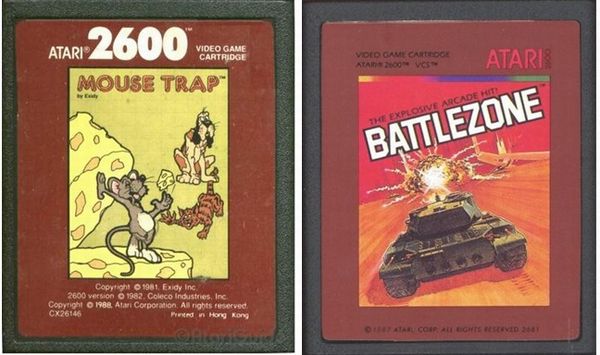
Above we have the two brown versions. PicBr1, brown 1 on the left, Mouse Trap, is similar to silver 1 version. It
has the large Atari logo in the center above the smaller photo. On the right, PicBr2, brown 2 on the right, is Battlezone.
Again, the photo got larger and the Atari logo is small and moved to the upper right corner. This is similar to silver 2 version.
There are not too many brown versions. They are much darker than their red counterparts, thus I gave it its own category.

Above are the 4 different licensed labels. These were aimed at kids. Each one has a checkered background. The first is
the Sesame Street games with the yellow label. There were four released in all. The purple label was designated for the Muppets.
The only released game was the Pigs in Space shown. The red label is for the Peanuts license. The only released game was Snoopy
and the Red Baron shown. The last cartridge is the blue label which was Disney. The only released game was Sorcerer's Apprentice
shown, but there was a Snow White release of the prototype in a collector's edition of 250 numbered pieces.
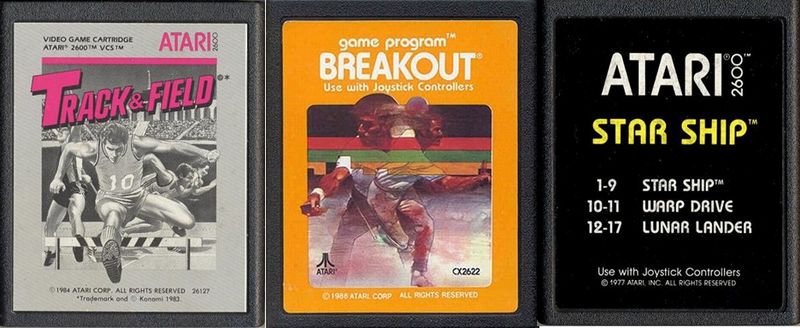
Atari made a few strange labels that are not categorized under any of the listings we've talked about so far. The one
on the left is Track & Field. This is the only label version known. The closest it would come is to a grey 2. The middle
cartridge is a late release of Breakout with an orange label. Another unique item, though Breakout has many variations. Star
Ship is our 3rd photo on the right above. This has been dubbed an "odd" label, again like no other released.
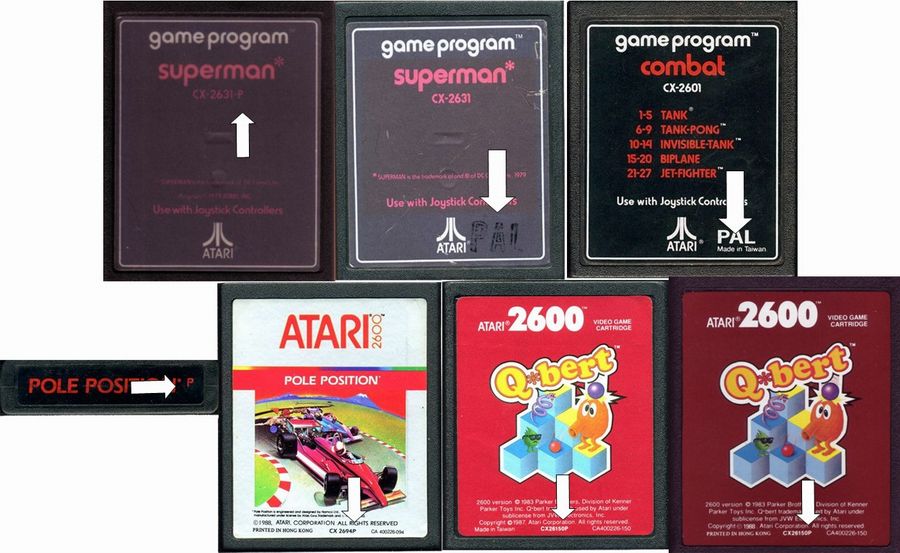
We move on to the PAL labels. These are in the PAL format, which cannot run on a normal tv. The screen will flip vertically,
thus you know you have a PAL cartridge. In most cases, you know you have a PAL cartridge because it is on the cartridge label
somewhere. Above we show the many examples of PAL cartridges. The first is the text label where the product number has a "-
P" added to it. The arrow points at this in the first Superman example. The second Superman shows a "PAL" stamped on the label,
also pointed out by the arrow. The third cartridge is Combat, where Atari actually printed PAL on the label as shown with
the pointing arrow.
On the second line, I began by showing only an end label, in this case it came off a silver version of Pole Position.
The main label does not have any notification the cartridge is PAL, but rather the "p" on the end label denotes it. Problems
arise if these end labels fall off. The "p" on the end label is found in the black, silver and sometimes grey picture labels.
Next to the Pole Position end label, we actually have a grey version of Pole Position where the "p" comes after the product
number on the main label. This is a rarity. On the red and brown labels, the "p" is printed after the product number. This
is the standard for PAL cartridges with these labels.
|

